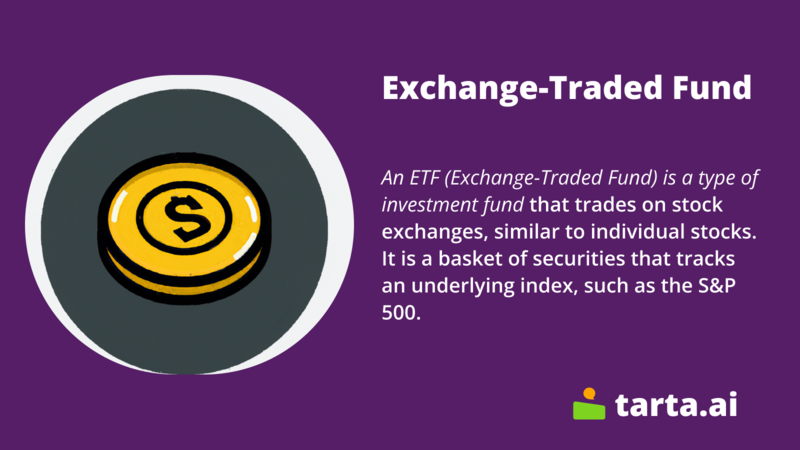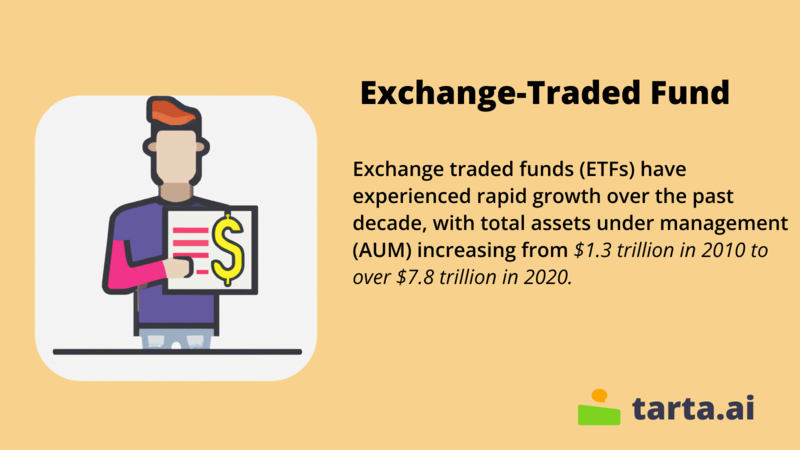What is Exchange-Traded Fund (ETF)? Understanding Benefits and Risks

What is an ETF?
ETFs are passively managed, meaning they seek to match the performance of their underlying index, and are traded like stocks, so investors can buy and sell ETF shares throughout the trading day at market-determined prices.
ETFs are passively managed, meaning that they aim to match the performance of their underlying index rather than beat it. Unlike actively managed funds, which are managed by investment professionals who try to outperform the market, ETFs are designed to provide investors with exposure to a broad market segment or asset class. The fund manager of an ETF makes periodic adjustments to the fund's holdings to ensure that it stays in line with the index it tracks.
ETFs are traded like stocks, so investors can buy and sell ETF shares throughout the trading day at market-determined prices. This makes them highly liquid, as investors can enter and exit positions quickly and easily. In addition, ETFs typically have lower expenses than actively managed funds, as they do not require a team of investment professionals to manage them. This can result in lower management fees and better returns for investors.
Fact
One of the main benefits of ETFs is their flexibility. ETFs can be used as a tool for implementing various investment strategies, such as long-term investing, asset allocation, or short-term trading.
How do ETFs work?
ETFs, or Exchange Traded Funds, are a type of investment vehicle that combines the features of mutual funds and stocks. ETFs allow investors to buy and sell a diversified portfolio of assets, such as stocks, bonds, and commodities, just like mutual funds. However, ETFs trade like stocks on an exchange, making them more flexible and transparent than mutual funds.
Here's how ETFs work:
- Creation: The issuer of the ETF creates a basket of securities that mirrors the underlying index or asset class the ETF is tracking.
- Share Creation: The issuer then creates new shares of the ETF, which are called creation units. These creation units are typically large blocks of shares, ranging from 25,000 to 500,000 shares.
- Trading: The creation units are then sold to authorized participants (APs), who are typically large institutional investors. APs can then sell individual shares to retail investors on an exchange.
- Tracking: The ETF tracks the underlying index or asset class by buying and selling the securities in the basket.
- Liquidity: Since ETFs trade like stocks, they offer investors the flexibility to buy and sell shares throughout the day on an exchange.
- Fees: ETFs charge management fees, which are typically lower than those of mutual funds, since they are passively managed and traded like stocks.
- Termination: ETFs can be terminated if there is no longer enough demand or if the issuer decides to close the fund. In this case, the assets of the ETF are liquidated and the proceeds are distributed to shareholders.
Overall, ETFs offer investors a convenient and cost-effective way to invest in a diversified portfolio of assets, with the flexibility to buy and sell shares throughout the day.
What are the types of ETFs?
Type of ETF | Investment Strategy | Examples |
Equity ETFs | Invest in stocks of various companies | SPDR S&P 500 ETF (SPY), Invesco QQQ Trust (QQQ) |
Bond ETFs | Invest in fixed-income securities | iShares Core U.S. Aggregate Bond ETF (AGG), iShares iBoxx $ Investment Grade Corporate Bond ETF (LQD) |
Commodity ETFs | Invest in physical commodities or commodity futures | SPDR Gold Shares (GLD), United States Oil Fund LP (USO) |
Currency ETFs | Invest in currencies | Invesco DB US Dollar Index Bullish Fund (UUP), WisdomTree Bloomberg US Dollar Bullish Fund (USDU) |
Sector ETFs | Invest in specific sectors of the economy | Select Sector SPDRs (XLK, XLF, XLI, XLE, XLU, XLV, XLP, XLY) |
International ETFs | Invest in companies or securities from a particular country or region | iShares MSCI EAFE ETF (EFA), iShares MSCI Emerging Markets ETF (EEM) |
Style ETFs | Invest in companies that fit a certain investment style | iShares Russell 1000 Growth ETF (IWF), iShares Russell 1000 Value ETF (IWD) |
What are the benefits of investing in ETFs?
- Diversification: ETFs offer investors exposure to a diversified portfolio of securities, which helps reduce overall investment risk. By investing in a single ETF, investors can gain exposure to a whole index or asset class, rather than having to select individual securities.
- Low costs: ETFs generally have lower expense ratios than actively managed mutual funds, as they are usually passively managed. This means that investors can save money on management fees and other costs associated with investing.
- Transparency: ETFs provide transparency around their holdings, so investors can see exactly what securities they are invested in. This helps investors make informed decisions about their investment portfolio.
- Tax efficiency: ETFs are typically more tax-efficient than mutual funds. ETFs have lower turnover rates than actively managed mutual funds, which means that they generate fewer capital gains distributions, resulting in fewer tax liabilities for investors.
- Accessibility: ETFs are available to all types of investors, from individual retail investors to large institutional investors, and are traded on exchanges around the world.
Overall, ETFs offer a cost-effective, diversified, and flexible investment option for investors looking to build a well-rounded investment portfolio.

What are the potential risks of investing in ETFs?
While ETFs offer many benefits, there are also potential risks associated with investing in them. Here are some of the main risks to consider:
- Market risk: ETFs are subject to market risk, which means that their value can fluctuate based on the performance of the underlying securities they hold. If the market experiences a downturn, ETFs may also experience a decline in value.
- Liquidity risk: Although ETFs are traded on exchanges, not all ETFs are highly liquid. In some cases, investors may have difficulty buying or selling shares of an ETF due to low trading volume, which could lead to wider bid-ask spreads and potentially higher transaction costs.
- Tracking error: ETFs are designed to track the performance of an underlying index or asset class, but they may not perfectly replicate that performance. The difference between the ETF's returns and the index's returns is known as tracking error, and it can be influenced by factors such as management fees, trading costs, and the composition of the underlying securities.
- Counterparty risk: Some ETFs use derivatives or other financial instruments to achieve their investment objectives, which can expose investors to counterparty risk. If the counterparty to the derivatives contract defaults or fails to perform, the value of the ETF could be affected.
- Concentration risk: Some ETFs may be concentrated in a particular sector, industry, or geographic region, which can increase the risk of the ETF if that sector, industry, or region experiences negative events.
- Operational risk: Like any investment, ETFs are subject to operational risk, which includes risks such as errors in index construction, failed trades, or other operational issues that can impact the ETF's value.
It's important to thoroughly research any ETF before investing and to consider your overall investment objectives and risk tolerance. Additionally, diversifying your portfolio across multiple ETFs and other asset classes can help mitigate some of these risks.
How are ETFs compared to other types of investment funds?
There are several types of investment funds that can be compared to Exchange Traded Funds (ETFs) in terms of their structure and characteristics. Here are some of the most common ones:
- Index funds: Like ETFs, index funds seek to track the performance of a specific market index. They are typically mutual funds that invest in the same securities as the index they are tracking, and their objective is to replicate the returns of that index.
Fact
Index funds offer exposure to a diversified portfolio of securities, they can provide investors with broad market exposure and potentially lower overall risk compared to investing in individual stocks.
- Mutual funds: Mutual funds are similar to ETFs in that they pool money from multiple investors to invest in a diversified portfolio of assets. However, mutual funds are not traded on an exchange like ETFs and are priced at the end of each trading day based on the net asset value (NAV) of the fund.
- Closed-end funds: Closed-end funds are similar to ETFs in that they trade on an exchange and have a fixed number of shares outstanding. However, unlike ETFs, they are not designed to track an index and their share prices may trade at a premium or discount to their net asset value.
- Hedge funds: Hedge funds are typically private investment funds that are not available to the general public. They are managed by professional investment managers and can use a wide range of investment strategies, including short-selling, leverage, and derivatives. While they are not traded on an exchange, they share some similarities with ETFs in terms of their ability to offer exposure to alternative asset classes and strategies.
Overall, ETFs are unique in their combination of low costs, tax efficiency, flexibility, and tradability, which sets them apart from other types of investment funds. However, the funds mentioned above can be compared to ETFs in terms of their investment objectives, structure, and characteristics.
- ETFs are investment funds that trade on a stock exchange like individual stocks.
- ETFs offer diversification benefits by holding a basket of securities, which can help reduce risk.
- ETFs have lower expenses compared to actively managed mutual funds, which can lead to higher returns over time.
- ETFs are highly transparent, as investors can see the holdings of the fund on a daily basis.
- ETFs are tax-efficient, as they typically have fewer capital gains distributions compared to mutual funds.
- ETFs can be bought and sold throughout the trading day, which provides investors with greater flexibility in managing their investments.
- ETFs offer exposure to a wide range of asset classes, including stocks, bonds, commodities, and alternative investments.
- ETFs are subject to market volatility and fluctuations, just like individual stocks and other investment funds.
FAQ
What is an ETF?
An ETF is an investment fund that holds a diversified portfolio of assets and can be traded on exchanges.
How do ETFs work?
ETFs track a specific index or benchmark and hold a basket of securities that mirror the index. Investors can buy and sell shares of the ETF on an exchange throughout the trading day.
What are the advantages of investing in ETFs?
ETFs have low expense ratios, are highly diversified, and offer easy access to a wide range of asset classes and markets.
Are there any risks associated with investing in ETFs?
ETFs carry some level of risk, including fluctuations in the value of shares based on market conditions and the performance of underlying assets. Leveraged or derivative ETFs can be more volatile.
How can I choose the right ETF for my investment goals?
Consider the asset class, expense ratio, investment strategy, and performance history when selecting an ETF. Consulting with a financial advisor is also a good idea.